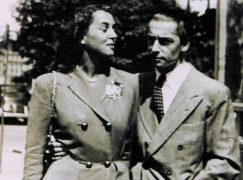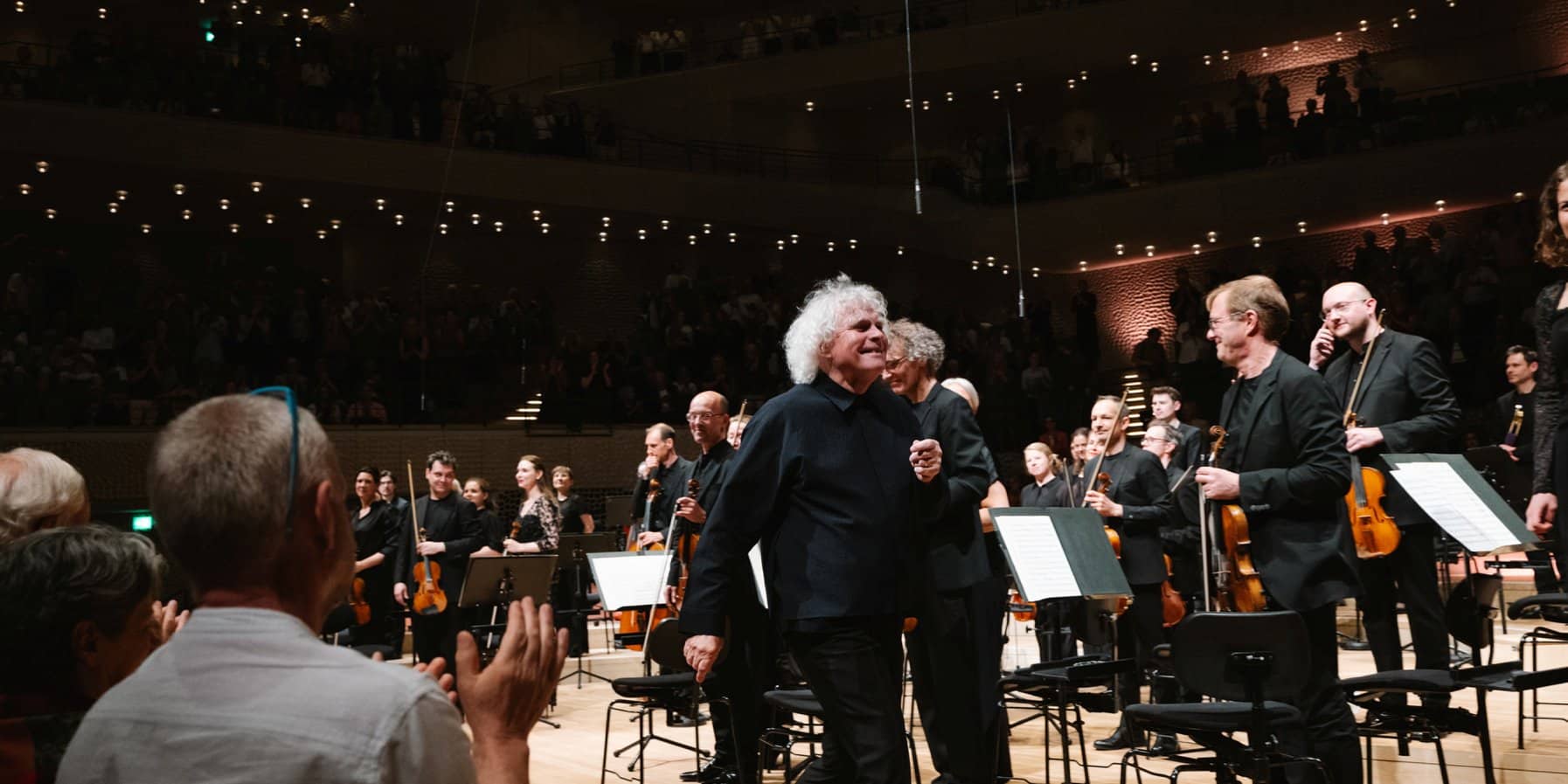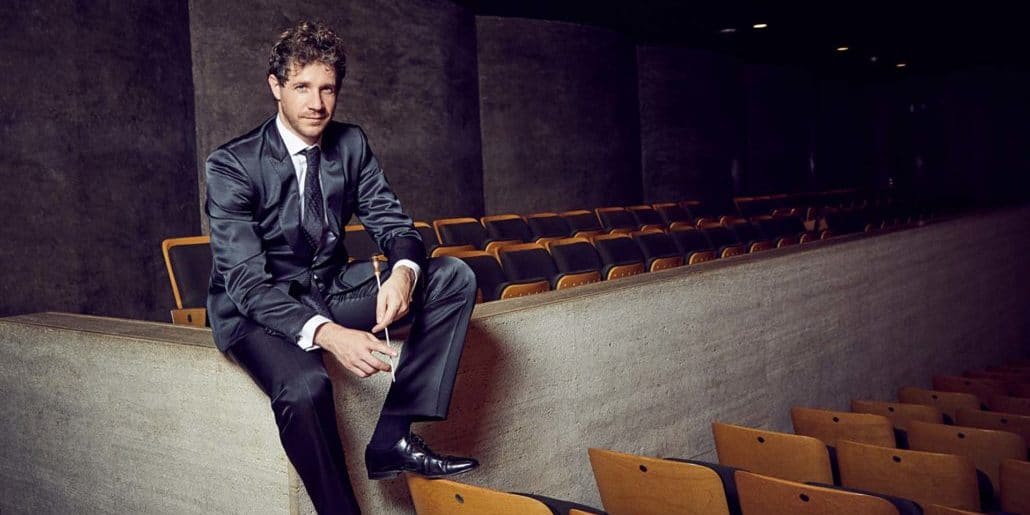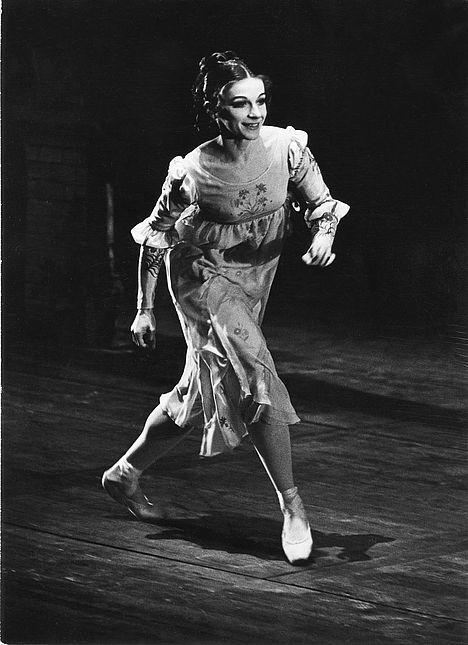Where Herbert von Karajan got his high heels
mainAccording to a new article, the conductor started wearing shoe inserts in Breisgau around 1940 in order to come up to the height of his statuesque second wife, Anita Gütermann.

Photo: Archive Klaus Riehle
More episodes from Karajan’s half-hidden wartime life here.





Page does not display.
And is there a reason why this even matters?
Here’s what does: There has never been a greater conductor of Bruckner’s amazing music, in my opinion. Karajan’s Wagner is magnificent. Much of Karajan’s music-making is superlative. Not all of it is–for example, Schubert is a composer that he seems clueless about.
If there is any sort of correlation between wearing shoe inserts and elevating one’s conducting talents , to produce music on the often unreachable levels that Karajan achieved, then a lot of other conductors would do well to immediately race to the nearest shoe store.
A lot of Karajan’s fame rested on his carefully cultivated appearance – he was rather an ugly young man but a new hair style changed that. His hobbies were well suited to his times: yachting, piloting his own aircraft. He was also backed up by critics determined to cover up his dubious past: one biographer skates quickly over his celebration of the fall of Paris by conducting in the presence of Nazi dignitaries concerts and “Tristan”, all preceded by the Horst Wessel Lied.
As Klemperer put it, he was the ideal conductor for our times (for better – frequently – and for worse (his grabbing of all the top jobs in Europe).
He got the top jobs because he deserved them. He got them because of his talent not because of the way he looked. Jealous people with questionable talent always try to bring their betters down.
Bingo, Simon.
What’s become really clear to me is that to a very large extent, there are those who criticize Karajan on any basis they can because he has become the bogeyman for the Third Reich–which in itself is nonsense. If anyone has actually read the scholarship that’s out there, specifically the detailed research of Richard Osbourne, it’s clear that Karajan was not a believing Nazi, but merely someone who was in the wrong country at the wrong era of history, who wanted to work in his chosen profession and did what he had to do to insure that. If he was a card-carrying Nazi who worshipped Nazi ideology, as some would have you believe, why in 1942 did he marry Anita Gutermann (his second wife), who by the standards of the time would have been considered a Jew by the regime and the public because she had a Jewish grandparent? In 1942, it still looked like it was a thousand-year Reich, not a failing regime that had a few years left.
I have no personal stake in this matter. I just let my ears tell me what they’re hearing, and what they tell me is that Karajan would get my vote as the greatest conductor of the 20th century, whose best performances (of which there are many) move me beyond words. I don’t like everything he did, but at his best, he was untouchable. And when he was not at his best, he was still often very good. The only real turkeys I’ve heard have been his forays into Schubert. And even when he ventured outside the central Austro-Germanic terrain, he still often produced outstanding results, such as his Sibelius, his Shostakovich 10–the best recording I’ve ever heard of that work including Mravinsky’s several performances that are available, etc.
If others don’t like Karajan, that’s fine with me. Don’t listen to his music. I’m not offended. But if you ever tried to take away his Bruckner recordings from me…
Agreed. Brain and eyes are good, but ears are better to judge music making. HvK was also extremely good at Pelléas, which is one of the best recordings of this elusive work ever.
“The only real turkeys I’ve heard have been his forays into Schubert.”
Try his Jeu de Cartes with the Philharmonia. Extraordinarily lumpy, especially compared with Munch.
His take on Symphony in C is very credible though, and his DG version of Bartok’s Music for SP and C has received high praise from Rob Cowan and David Hurwitz no less.
+1.
couldn’t agree more!!
Karajan was and will be one of the greatest conductors of all timed regardless of his eccentrics….it’s the quality of his music making which will prevails, be it Beethoven, Bruckner, Brahms, Wagner, Strauss, Verdi or Puccini.
True. It always greatly irritated me to see HvK being hyped-up and his ridiculous sleeve covers with his ‘serious profile’ demonstrating the ‘nobility of Hvk = classical music in general’, but what remains are his incredible recordings. For instance, there is his stunning recording of Götterdämmerung which never fails to impress as the definite way of how this music should sound.
He did not need all the nonsense:
https://chatterleyluxuries.com/product/montblanc-special-edition-herbert-von-karajan-fountain-pen/
https://commons.wikimedia.org/wiki/File:Salzburg_Karajan-Statue_02.jpg
https://newsroom.porsche.com/en/christophorus/issue-382/porsche-911-turbo-rs-maestro-herbert-von-karajan-salzburg-13945.html
Also, it is greatly absurd that a single performer of classical music can get richer than ALL classical composers from 1700 onwards combined:
http://www.classicfm.com/discover-music/latest/incredible-facts/karajans-wife/
My (wink) did not come through on that last posting, so let me just re-state it here more obviously:
If there is any sort of correlation between wearing shoe inserts and elevating one’s conducting talents (wink), to produce music on the often unreachable levels that Karajan achieved, then a lot of other conductors would do well to immediately race to the nearest shoe store.
My guess is that discussing Karajan’s shoe inserts is just another excuse at taking a shot at him.
While we are at it, I do see it as early sign of one of his most appalling sides: his emphasis on image. When I first attended a Karajan concert, I was surprised to notice that he was rather short. I would have never guessed from his pictures in the media. (I once asked a girlfriend who had never seen him live to guess his height: she thought he was very tall.)
The worst manifestation of Karajan’s obsession with image was in the filming of orchestral performances. He had orchestras do the instrumental equivalent of lip synching. In the 1960s, before live recordings became commonplace, he often had new visual footage of orchestral musicians replace the original one. Sometimes it wasn’t even the same musicians: musicians with beards were replaced by clean shaved ones. Evidently between power and financial motivation, the Berlin and the Vienna Philharmonic musicians held their noses and went along.
https://www.youtube.com/watch?v=UgKW8wWlYT4
My personal opinion is that at his best Karajan was as good as any conductor, especially in opera. His live recordings from the 1950s and 1960s, especially from Salzburg, sound much better than most of his studio recordings from the 1970s and 1980s. Many of the latter have a very nice pacing and polished sound, but lack polyphonic transparency or characterization.
After watching a few of the videos that are available in Digital Concert Hall of Karajan and the BPO, I have often wondered: Did he actually not look at the orchestra (i.e., eyes closed, looking down, etc..) when conducting? Or was this just a performance he did for the camera?
I saw him conduct Figaro at the 1972 Salzburg Festival. I was a few rows back but slightly off centre and so could see his head quite easily. From the start his head was down, In the first Act Bartolo aria, Paolo Montarsolo had some problem with the tempo. Most conductors in my experience would have looked up and tried to help him. I suppose Karajan felt that was the job of the promoter for he never looked up once at the stage. Yet when Elizabeth Harwood as the Countess came on at the start of Act II, he could not take his eyes off her!
Clarinetist Jack Bruner in his book, From Where I Sit, wrote about his first encounter with Karajan. He rehearsed normally, eyes making contact. Then at the concert, eyes closed. It was quite disturbing. Karajan wasn’t the only short conductor. Beecham, too.
HvK closed his eyes in an expression of introvert, mystical intensity, exuding an invisible atmosphere of metaphysical power, which was so attractive, commercially, for the LP sleeves. For Germans, that worked. But for Brits, for instance, much less so: there is this story that at a first rehearsel with the Philharmonia in London shortly after the war, K took his metaphysical position and began to slowly beat time for the first bars of a Bruckner symphony. But there was no sound, as all players looked puzzled at him and did not know how to react. So that had to start again, now with eyes wide open.
They are a tad over-choreographed I’d agree.
The gain is that quality of film is such that they look as if they were made a few years ago as opposed to the late 1960s in the case of the Tchaikovsky piano concerto with his the equally image conscious Alexis Weissenberg.
“The worst manifestation of Karajan’s obsession with image was in the filming of orchestral performances.”
IMO the worst manifestation of Karajan’s obsession with image was and is the layout of the Berlin Philharmonie, the ‘Circus Karajani’.
Against all sensible advice, Karajan and Sharoun pushed through their purely visual concept, an architectural layout that puts the conductor in the middle of attention instead of the music and its sound. That bastard of a concert hall – a classical music-show-theater layout – had many offsprings unfortunately, and has destroyed a lot of music that could have arrived with great impact and balanced tefinement at the listener’s ear, but didn’t.
great architecture though, visually, no doubt.
^ (the point being that “visually” should not have been the point)
Agreed.
Quite agree. Two weeks ago I visited Berlin for the first time and went to Berliner Philharmonie for the Argerich and Barenboim duo recital which understandably attracted a full house. The architecture, with its mazes of angular stairways, however, was aesthetically very unpleasing, very much like the city of Berlin itself. It is also user-unfriendly. I’m a relatively young person but a lot of attendees were seniors who had to slowly navigate through all those stairs on different floors. The intermission was chaotic with herds of people trying to find their way to the long lines in front of bars and receptions. The place looked like refugee camp or a badly managed bus station.
I’ve been in the Philharmonie twice and loved it. Had no issues with the sound (seated either behind or up in section F, I think) and love the proximity. I actually don’t like a lot of the shoebox halls, including Symphony Hall; too many seats with lousy views, too many are far from the orchestra, and the sound under the balconies isn’t particularly good. Chaq’un a son gout.
@Macrov: it doesn’t matter how close you sit to a singer, if all you see (and hear) is his or her backside. Unless that’s what floats your boat and makes you buy tickets for classical concerts. There are more efficient ways though, to satisfy that kind of desire. 😉
C’mon…it is Norman Lebrecht talking aboit HvK. You cannot expecte less than it. 😉
Better « Heel » than « Heil » … that’s for sure … !!
Cubs Fan has the name wrong.
It is Jack Brymer (not Bruner), the clarinetist who wrote the book From Where I Sit (published in 1979).
I knew that…but alas, no way to edit once posted. Stupid, irritating Android spell check…
Standard procedure, if you wish to show that you caught your own error, is to post an reply to your own comment, with your correction.
to post **a** reply to your own comment 🙂
(see how that works?)
When I applied for this job here, I found that I was the only one turning-up, and at the end of the interview I was told that I would be taken-on, on the condition that I would not wear ‘these offensive high heels’ which I was wearing to compensate for my CV. (I had to take foot baths all day long the next day.) I now wear molières when working, but can still throw my weight around, so to speak.
I never understood why conductors need a rostrum, if they would wear high shoes, they could jump around much more freely and be much more impressive in the green room. I somewhere read something about shoes with springs, that would be perfect for concerts, wouldn’t it be nice for Mirga? O, I ‘m told here that I should not indulge in gossip, sorry!
Sally
Dear Sally,
Can one give higher praise to Mr Karajan than still making gossip about his use of high heels 30 years after his passing?
So it is! We talk about Herbert’s heels because of his Beethoven but is that a good thing? Patriarchal suppresion, etc. One day in my second week I came on my stiletto pumps to see if it made a difference, and however I click-clacked on the marble here, it was not noticed at all. But at least I didn’t harm anybody.
Sally
Saw him conduct the Berlin Philharmonic in ’82 at Ambassador Auditorium (Pasadena, CA). The shoe inserts didn’t do anything for his physical stature, but I enjoyed their Strauss “Alpensinfonie” anyway.
“Ich lieg’ und besitz: lass mich schlafen!!!
I have and I hold- let me sleep!!
(Siegfried, 2nd act)
I’ll grant you that he was ONE of the greatest conductors of the 20th century. But what about L Bernstein, or G Solti. They conducted a few good little ditties themselves, and GS won all the Grammys!
Not sure I would have chosen either as an example of “clearly better conductor” since Solti is often bombastic and over-driven and Bernstein (a fantastic educator) is frequently sloppy.
However, among conductors of the Berlin Philharmonic Orchestra, a case should be made for Nikisch, Furtwangler, or Abbado being at least as good, if not better conductors.
For what it’s worth, Tuckwell said Szell was a demanding conductor, but the London Phil rehired him twice. (Musicians hired the music director.)
I’m going off on a slight tangent. Much has been written above about HvK’s head down, closed eyes style of conducting – what John Borstlap above refers to as “an expression of introvert, mystical intensity, exuding an invisible atmosphere of metaphysical power.” Cubs Fan states clarinettist Jack Brymer was disturbed when working with an HvK with his eyes closed.
Many years ago I picked up the Bel Canto Society DVD “Great Conductors of the Third Reich: Art in the Service of Evil.” One track shows Karajan conducting the start and end of the Meistersinger overture in occupied 1941 Paris with the Bayreuth ensemble all led by the ghastly Winifred Wagner. In the sweeping over-extravagance of his gestures (outdoing virtually every conductor of today), his head always up looking at the orchestra – indeed sometimes it seems as though to the ceiling – there is a near-overt triumphalism in the conducting. It is the total antithesis of the Karajan as portrayed after the war. I am wondering when and why HvK so radically changed his conducting style.
Probably the devastating Götterdämmerung of 1945 and the opening of the concentration camps had something of a sobering influence upon his ideas.
Herbert von Karajan image-conscious? Not like Yuja Wang, aye!!
A Doktor writes: “And there is a reason why this even matters?”
Well, given that HvK was in later years crippled by lower back problems, it might have a bearing (literrally), don’t you think?
As for his early ‘posturing’, well he was a young man then making his mark. All young conductors throw their arms around,not least because they can. When reputations are established and a commanding presence on the podium has been achieved, gestures can be restrained. You can see a similar conceit in Gergiev’s toothpick…
I find it quite strange, the variation in the size of conductor’s batons. It does look like Gergiev conducts with a toothpick. I was watching a DVD of Sir Adrian Boult conducting Vaughan Williams the other evening and he had one the size of a snooker cue. It was just as well he was standing well back from the orchestra or he would have had someone’s eye out.
Gergiev; not just a toothpick but fluttering fingers. I hope to see both next year.
Actually, Karajan attributed his spinal/back problems to a very bad fall he had skiing as a kid.
Maybe he fell because he had ‘lifts’ in his ski boots? 😉
Or maybe he was off, pissed.
A notification and/or warning that following a link would take you to a non-English site would be appreciated.
Surely the glaring omission in the HvK catalogue is that masterpiece by Delius: “Song of the High Heels”….altho if events had turned differently, it might have been: “Song of the He Heils.”
The fact that 30 years after his demise we are debating not only heels but his looks, his style and above all his music tells me that he is still very much a ‘presence’ in the modern world. Long live HvK
Bravo! HvK will live forever…